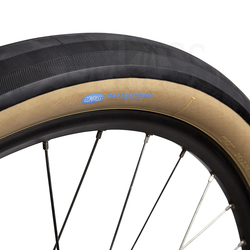Looks like you missed the
memo from Continental.
Doesn't meet the 'fast' criterion of the OP (adds 8-10 minutes to my 20-mile each-way commute for the same effort), but is most definitely a non-studded winter tyre for paved road use. It copes with general ice very well, and is not as horrendously slow or heavy as studded tyres (which add 15-20 minutes to the commute) - although for extensive sheet ice (which I rarely see), studded tyres are preferable. Has the benefit of gripping reasonably well on metal surfaces too, which studded tyres can be lethal on.
Thanks for pointing out yet another marketing exercise to appease a market that doesn't understand physics.
Continental says:
For the serious winter cyclist - Handmade in Germany!
(1) We contribute all of our leading know-how as one of the leading automotive winter tyre producers in the new Top CONTACT Winter II. And it shows...
(2) The tread design's outer appearance alone is convincing due to its never-ending-grip design which extends far into the shoulder area. (3) Thanks to countless lamellae, hundreds of biting edges interlock with the terrain that you are riding on, be it tarmac, gravel or snow.
(4) The compound is adapted to work in colder temperatures and so this tyre will keep you going when other riders are spinning their wheels.
(5) Made with a supple 180 threads per inch (tpi) polyamide base casing with three plies (3ply/180tpi), plus our Poly X additional densely woven anti-puncture ply beneath the tread.
The Top CONTACT Winter is available in the MTB sizes of 26 x 1.9 & 2.2 and 700c sizes of 37 & 42mm.
- (6) For the northern winter
- (Hundreds of biting edges across all tread lugs help interlock with snowy terrain
- Including our PolyX anti puncture material under tread
- Specifically designed to work in cold temperatures
Let's look at this statement carefully: first sentence.
Know-how in automotive winter tyre production doesn't translate to automatic know-how in bicycle tyres. I'm not saying they don't know what they're doing. I'm just pointing out that they like to dupe the public into thinking that tyres are tyres and car tyre technology extends to bicycle tyre technology. It doesn't.
Second Sentence.
Here they like to play on the public's perceived knowledge about tread and grip. More aggressive is better, they say. Wrong! Smooth is better. We've discussed it here
ad-infinitum. Have a look at how far the tread extends into the shoulder and show me the person that corners at 60 degrees from the vertical. In other words, the extra tread is just there to give it a gnarly look and to fool you. Be my guest, buy it.
Third sentence.
Lamellae? Continental seems to confuse the word with cuts or sipes. Lamellae is layers. Sipes are grooves/cuts. Clearly it has to be the latter. However, Continental can afford a dictionary, but prefers to use cute words to appeal to the gullible consumer who is scared of smooth tyres in winter. That same sentence now says that these layers cut into tarmac. Better not tell the roads authorities, because that sounds pretty destructive. Anyway, please buy this, it sounds plausible, doesn't it? Funny they don't promise that it interlocks with ice. That would have been nice. Rhyme not intended.
Fourth sentence. Here's an ace - the use of the world "Compound". It is so Formula-1-sh it just have to have merit. There is some merit in using rubber that doesn't go hard when the temperature drops but this particular compound doesn't perform well when the temperature goes above 7 degrees C. I doubt Continental even uses a different rubber but I'll give them that one. I do like the touch where other riders are spinning their wheels. I must say I find it difficult to not smoke out my rear tyre when I accelerate hard in winter.
Fifth sentence: Supple 180 TPI casing. High thread count casing has nothing to do with grip and everything to do with rolling resistance and puncture protection. By going high, the threads go thinner, so it contradicts the tyre's claim of being puncture resistant. You can't have your cake and eat it. I like the use of X in the Poly X. It gives it a nice scientific name. Polyester is just soooo unfashionable! Anyway, the casing has nothing to do with gripping on ice.
Sixth sentence: Funny that these tyres won't work in a southern Winter. I guess New Zealand is screwed here.
And so on.
Since Continental doesn't claim that this tyre "copes with general ice very well", but you did. I'd like you to explain what general ice is and how you've found these tyres to cope better with general ice than other tyres. Feel free to quote figures.


